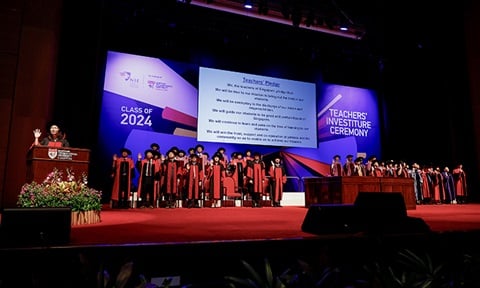Magnifying a Teacher's Impact
A teaching stint in Denmark taught Mr Lishanth Thangavelu an important lesson on what it means to be a good teacher. What stood out was the strong rapport between the teachers and students in the classroom.
“Their teacher-student relationship was amazing,” says the 29-year-old, who teaches physical education (PE) at Seng Kang Secondary School. “It is very hard to find that kind of bond in Singapore – there are 42 students in my class and it is more difficult for me to know every student in depth.”
That is why he seizes every opportunity to get to know his students better and build trust with them.
In his roles as a PE teacher, a member of the discipline committee and part of an after-school programme to engage at-risk students, he tries to carve out pockets of time to engage students who have disciplinary issues or are struggling to cope with their studies, be it one-on-one or in a group setting. Mr Lishanth realised the impact of teachers could be vastly magnified if they were able to empathise and connect with their students on a more personal level.
One key lesson he picked up from the Denmark trip in 2016 – which took place when he was an undergraduate at the National Institute of Education (NIE) – is that being harsh with students is not an effective way to gain respect or control a class.
Striking a balance
Instead, he learnt to strike a balance between being firm and being empathetic. Building positive teacher student relationships is a continual process. Every January, a teacher encounters new faces and personalities.
To continue honing his skills in this area, Mr Lishanth requested to be assigned to a challenging class.
Last year, he was assigned as the form teacher for a Secondary 3 Normal Technical (NT) class. These classes pose more difficulty for teachers because pupils might need more guidance and individual care to perform well in school.
To effectively engage his class, Mr Lishanth had to adapt his communication style.
“Over the years, I realised what works with one class may not work with another,” he says.
“It is really about finding what fits that class profile the most.” Mr Lishanth stresses that it takes time – sometimes years – for teachers to see the results of their efforts.
“It could be as long as four to five years,” Mr Lishanth points out. “You may only learn about your impact when they come back after graduation and tell you about it.”
Transforming lives
However challenging the work may be, he says it also yields some of the most meaningful and rewarding moments. Mr Lishanth recalls one particular student who was on the school’s hockey team. As the co-curricular activity’s Secondary 2 captain, he was a star player but constantly faced discipline issues in class.
However, instead of cracking the whip, he opted for empathy and care.
“Through many conversations, I encouraged him to channel the same resilience he displayed on the pitch into the classroom,” says the teacher.
Over time, he saw steady improvement. The student matured and the discipline issues eventually subsided.
Three years later, when he was in Secondary 5, the student won the Edusave Character Award – a prestigious prize for students who demonstrate exemplary character.
only one student in the school can receive.”
Source: The Straits Times © SPH Media Limited. Permission required for reproduction.






.tmb-listing.jpg?Culture=en&sfvrsn=24c8c5ab_1)
.tmb-listing.jpg?Culture=en&sfvrsn=f6ef902b_1)